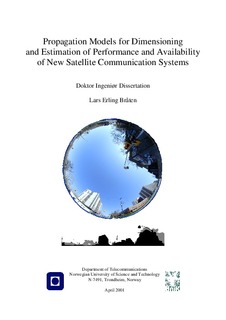| dc.contributor.author | Bråten, Lars Erling | nb_NO |
| dc.date.accessioned | 2014-12-19T14:11:33Z | |
| dc.date.available | 2014-12-19T14:11:33Z | |
| dc.date.created | 2001-07-02 | nb_NO |
| dc.date.issued | 2001 | nb_NO |
| dc.identifier | 125441 | nb_NO |
| dc.identifier.isbn | 82-7984-191-1 | nb_NO |
| dc.identifier.uri | http://hdl.handle.net/11250/261485 | |
| dc.description.abstract | A rapid growth of new satellite systems utilizing the Ka-band (27 – 40 Ghz) and even higher frequencies is expected in the coming years. The services offered will include broadband communication, interactive broadcasting, multimedia applications, interconnection of local area networks and Internet connectivity. Many of the new systems will use technologies as multiple spot-beams, onboard processing, and switching of packets between beams and inter satellite links. Because of congestion in the lower bands such ad C (4 – 8 Ghz) and Ku-band (12 – 18 Ghz), numerous of these services will use Ka-band. One additional advantage to the spectrum availability at Ka-band is the potential of smaller terminals compared to those used in lower frequency bands.
Several mobile satellite systems have recently started operation and more are planned or scheduled for implementation within a few years to provide personal and data communication at L-band (1 – 2 Ghz) and S-band (2 – 4 Ghz) frequencies. The systems will utilize different orbit types, for example low, medium or geostationary earth orbits, to provide voice and data services to mobile users.
Understanding of the propagation aspects is important for successful design of a satellite system obtaining the targeted service quality and availability. For systems operating above about 10 Ghz, attenuation caused by hydrometeor effects is the dominant propagation impairment on line-of-sight (LOS) links. For mobile communications systems operating at lower frequencies, the impairments resulting from multipath propagation, shadowing and blockage from obstacles on the ground severely affect the radio signals. Estimation of dynamic propagation is essential for the design of reliable and spectrum efficient communication systems. The system can adapt the transmission methodology that maximizes the throughput of information and optimizes the delivery time. The design of such mitigation techniques will depend on the dynamics and how often the events occur.
The research conducted in this study on mobile propagation effects of terrain at L-band has led to an improved three-state channel model for land mobile satellite systems. The time spent in each of the states is quite realistic, facilitating better simulation of the performance of communication systems. A new methodology was developed to perform large area coverage estimation by calculating satellite visibility for low earth orbit and geostationary constellations based on digital terrain maps. The procedure takes into account large terrain obstacles and procedures a gross overview of the potential area covered with one or several satellites. A photogrammetric technique to assess performance of non-geostationary orbit (NGSO) systems in mid- and high latitude urban areas was used to estimate channel fading and diversity improvement. Some measurements of the maximum obtainable call duration for the Iridium system are included as well.
The studies on atmospheric propagation effects between 20 and 60 Ghz included analyses of fade and inter-fade duration statistics, which are important when evaluating fade mitigation techniques and estimating system outages. Fade duration measurements were analyzed and an effort made to find a common statistical fade duration model. Based on this work, a new prediction method for fade durations on satellite-earth paths was developed. This ability to forecast rain attenuation was investigated with the aid of statistical prediction methods and terrestrial measurements on a 60 Ghz link. Finally, beacon measurements at 50 Ghz from Italsat F1 were used to test and compare available scintillation prediction models.
The work has improved the ability to estimate and simulate propagation effects on mobile and fixed satellite system performance. | nb_NO |
| dc.language | eng | nb_NO |
| dc.publisher | Fakultet for informasjonsteknologi, matematikk og elektroteknikk | nb_NO |
| dc.relation.ispartofseries | Dr. ingeniøravhandling, 0809-103X; 2001:28 | nb_NO |
| dc.relation.haspart | Bråten, Lars Erling; Amava, César; Rogers, David V. Prediction of Coverage for a LEO System in Mid- and High-Latitude Urban Areas Using a Photogrammetric Technique. Proc. IEEE Vehicular Technology Conference. 4: 2930-2934, 2001. | nb_NO |
| dc.relation.haspart | Bråten, Lars Erling; Kawai, N; Louahdi, Y; Tjelta, Terje. Modelling of Mobile Satellite Channels Based on Measurements at 13º and 29º elevation angle. Proc. Tenth International Conference on Antennas and Propagation (ICAP'97), Edinburgh, UK, 14-17 April 1997, 1997. | nb_NO |
| dc.relation.haspart | Bråten, Lars Erling; Tjelta, Terje. An Improved Three-State Semi-Markov Model Optimised for Land Mobile Satellite Communication. Proc. AP2000 Millennium Conference on Antennas and Propagation, Davos, Switzerland, April 9-14 2000., 2000. | nb_NO |
| dc.relation.haspart | Bråten, Lars Erling; Amava, César. Fade Duration at Ka-band on a Satellite-Earth Link in Vancouver: Modeling and Comparison with Measurements. Proc. IX Simpósio Brasileiro de Microondas e Optoeletrônica (SBMO'IX), Joao Pessoa, Brazil, 7-11 August 2000, 7-11, 2000. | nb_NO |
| dc.relation.haspart | Bråten, Lars Erling; Amava, César; Rogers, David V. Fade and Inter-fade Duration at Ka-Band on Satellite-Earth Links: Modeling and System Implications. Proc. AIAA International Communications Satellite Systems Conference, Toulouse, France, 17-20 April 2001, 2001. | nb_NO |
| dc.relation.haspart | Bråten, Lars Erling; Åsen, Walther. Prediction of Time Dynamic Rain Attenuation at Millimetre Wavelengths. Proc. AP2000 Millennium Conference on Antennas & Propagation, Davos, Switzerland, April 9-14 2000, 2000. | nb_NO |
| dc.subject | Electrical engineering | en_GB |
| dc.subject | Telekommunikation | en_GB |
| dc.subject | TECHNOLOGY: Electrical engineering, electronics and photonics: Electrical engineering | en_GB |
| dc.subject | Information technology: Telecommunication | en_GB |
| dc.title | Propagation Models for Dimensioning and Estimation of Performance and Availability of New Satellite Communication Systems | nb_NO |
| dc.type | Doctoral thesis | nb_NO |
| dc.contributor.department | Norges teknisk-naturvitenskapelige universitet, Fakultet for informasjonsteknologi, matematikk og elektroteknikk, Institutt for telematikk | nb_NO |
| dc.description.degree | dr.ing. | nb_NO |
| dc.description.degree | dr.ing. | en_GB |
